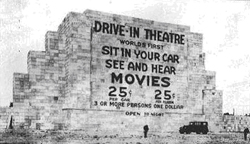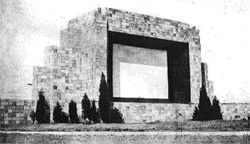From the Archive
Issue 19/120
2008

The screen tower of the first drive-in at Camden, New Jersey, June 1933.
Sights and Sounds
Our current issue, devoted to sight and sound in Whitman, Whitman Studies, and modern American culture generally presents a range of work related to the ways in which Whitman has been seen and heard over the course of two centuries in the U.S.
Whitman’s house on what was Mickle Street (now Martin Luther King, Jr., Blvd) in Camden was a place where sights and sounds collided for Whitman, as he would look out his first-floor window and watch the flow of goods and people going down to and coming back from the seaport. Later, not long after Whitman’s death, RCA built its headquarters just a few blocks from Whitman’s house, and Camden thus became the capital of sound recording and of the manufacture of sound recording technology. Some years later, in 1933, Camden became the first city in the country to have a drive-in movie theatre, synchronizing images and sound.
In this special issue we make available for the first time a wide range of spoken word LPs featuring actors reading from Leaves of Grass and educational videos about aspects of Whitman’s life and writings. It is hoped that this archive will be useful to both scholars and teachers of Whitman at all levels who are interested in issues of performance and interpretation.

Screen of the first drive-in. Photo from Tim Thompson’s Drive-In Theater.com. June 1933.
In keeping with this multimedia and hypermedia emphasis, the articles, feature pieces, poetry, and reviews published here address in various ways Whitman’s performance modalities and the sites, many of which splice together sight and sound, in which performances of his work took and take place. Ed Whitley contributes an article reflecting on his work on the website The Vault at Pfaff’s: An Archive of Art and Literature by New York City’s Nineteenth-Century Bohemians. Elizabeth Lorang discusses the issues surrounding the editing of Whitman’s journalistic poetry for the publicly accessible Walt Whitman Archive. John Tessitore takes up the issue of the Boston banning of the 1860 edition of Leaves of Grass and Whitman’s connection to Free Religion, putting into a more thorough historical context how Whitman was seen and heard by various factions in Boston during those years.
Zoe Trodd, who, like Whitley, places Whitman in the milieu of nineteenth-century bohemianism, takes care to place him in a longer tradition of American protest literature, finding that while “Whitman had sensed earlier voices,” responding to them in his work, others after Whitman “listened back to Whitman’s voice.” She points out that Whitman is read into and read aloud at the scene of political protests, especially those revolving around the gay rights movement. Jason Stacy analyzes Whitman’s attempts to negotiate early consumerism while maintaining the ideals of artisan republicanism and Hicksite Quakerism in his exploration of labor and the nascent consumer economy, locating in his early journalistic performances a carefully crafted sounding of public politics.
In feature pieces, the documentary filmmaker Robert Emmons trains his eye on the Whitman cartoons of Jeremy Eaton, which, he argues, have much to tell us about American political culture through their imagery. Geoffrey Sill reveals for the first time a recovered and restored photograph of Whitman (or is it a photograph of a painting of Whitman?) derived from one of his famous sittings; and Michael Robertson and David Haven Blake provide a useful blueprint, based on experience, of a communal reading of “Song of Myself.”
We also offer here, in the Documents section, Jesse Merandy’s hypertext of “Crossing Brooklyn Ferry,” a poem that is itself about the links made between and among people transhistorically. The poems of Judith Baumel, Adam Bradford, and Kim Roberts also help to situate Whitman in the larger American scene, both during his life and in death.
Finally, our two crack reviewers—Roberta Tarbell and William Pannapacker—weigh in on Ruth Bohan’s book on Whitman and visual art and Kenneth M. Price’s investigation of Whitman and popular culture, respectively.
Happy listening!
– Tyler Hoffman, Editor
- Walt Whitman in the Pulpy Flesh: The Poet as Illustrated in the Comics of Jeremy Eaton
By Robert A. Emmons Jr. - “O the Orator’s Joys!”: Staging a Reading of “Song of Myself”
By Michael Robertson and David Haven Blake - A New Photographic Image Of Walt Whitman
By Geoffrey Sill
Introduction to the Viewing Room
Walt Whitman’s words on film go way back.
The films archived in this issue are mostly educational in purpose, and can tell us much about the way Whitman was heard and seen throughout the twentieth century in America. The actor Efrem Zimbalist, Jr., narrates the 1972 short film Walt Whitman, in a series on “Poetry by Amercans” (Oxford Films, Hollywood, CA). In the study guide that accompanies the reel-to-reel film, we read that “Original art work is combined with period photography and engravings to introduce the student to one of America’s most distinguished poets and his work.” A centerpiece of the film is “O Captain! My Captain” which is used to reflect on recent dire political events: “As read by the film’s narrator … and powerfully represented on the screen, the poem speaks not only of Lincoln but of more recent loved but fallen leaders.” As we listen to the poem as read by Zimbalist, we see images of Lincoln, JFK, MLK, Jr., and Robert Kennedy. A question proposed for class discussion in the study guide includes the following: “Why do you think the poem O Captain! My Captain!might well be read in tribute to John Kennedy, Martin Luther King, or Robert Kennedy?” With emphasis on the spoken word, the study guide further suggests that the teacher “Ask for volunteers to read O Captain! My Captain!”: “Select a different student to read each stanza. Discuss oral reading of poetry.”
In the 21-minute-long Walt Whitman the Poet, which, which was filmed over a 25-year period, with Whitman’s biographer, Gay Wilson Allen, serving as consultant, scenes include those of the Whitman homestead (birthplace); the Long Island seashore; rural Long Island; Brooklyn; Manhattan. The words of Whitman are spoken by Marvin Miller, and “the story is told entirely in Whitman’s own words.” Walt Whitman’s Western Journey (1965) depicts Whitman’s trip to the American West, as far as to Colorado, in 1879.
In the 1972 15-minute film Walt Whitman’s Civil War, the poet is played by the actor Will Geer: “Archive photographs and filmed representations of the war so closely parallel the [t]ext that they might almost have been taken by Whitman to document his experiences.” A question posed in the pamphlet that accompanies the film asks us to imagine Whitman’s reaction to the era of the Vietnam War might be: “If Whitman lived today, what do you think his stance would be on the various social and political issues confronting us (integration, busing, the draft, involvement in Southeast Asia, communes, free love, health foods)?”
In each of these films, we see how Whitman was held up as a lens through which to view contemporary politics, especially nationality, in order to make him culturally relevant to us as well as to make us more aware of our own history.
Multimedia
Length: 19:50
Filmed, Produced, and Edited by: Francis Raymond Line and Helen E. Line
Consultant: Dr. Gay Wilson Allen Editor
Whitman’s voice: Marvin Miller:
Line Films
Walt Whitman’s Western Journey
Length:15:08.1
Original format: 8 ” reel
Filmed, Produced, and Edited by: Francis Raymond Line and Helen E. Line
A Line Films Production
Consultant: Dr. Gay Wilson Allen
Whitman’s voice: Marvin Miller
Walt Whitman’s Leaves of Grass
Length: 21:05.7
Original format: 10 ” reel
A Line Films Production |
Editor: Dr. Gay Wilson Allen
Whitman’s voice: Marvin Miller
Walt Whitman’s Civil War
Length: 14:27
Churchhill Films Inc.
Produced by Magus Films; 1972
Poetry By Americans: Walt Whitman
Length: 10:34
Original format: 7” reel
Oxford Films Inc.
Directed by: Stuart O’brien
Consultant: Allan Varnell Ph.D.
-
Issue Credits
Mickle Street Review is sponsored and published by the Department of English at the Camden campus of Rutgers, The State University of New Jersey.
ORIGINAL WEB DESIGN
Jesse MerandyVISIT THE
Original Website -
EDITOR
Tyler HoffmanEDITORIAL BOARD
JT Barbarese
Ed Folsom
William Pannapacker
Kenneth Price
Geoffrey Sill
Carol Singley
Gary SchmidgallMANAGING EDITOR
Jesse MerandyASSISTANT
MANAGING EDITOR
Evan James Roskos

Part of the Camden Online Poetry Project.
Copyright | Rutgers University – Camden.
Supported in part by a grant from the
Gilder Lehrman Institute of American History.
